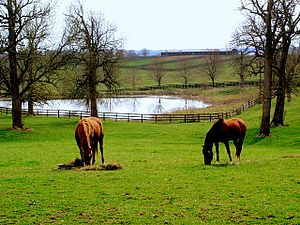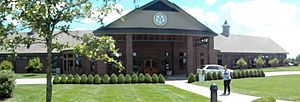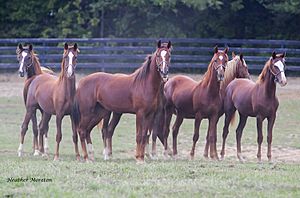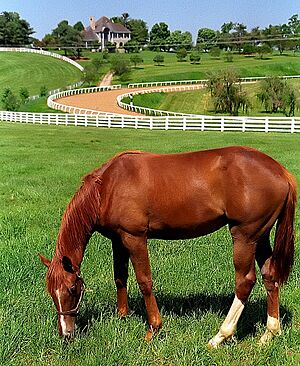Equine industry in Kentucky facts for kids
The horse industry in Kentucky is a very important part of the state's farming business. It includes many different parts, like breeding and raising horses, horse racing, buying and selling horses, and even tourism. In 2012, this industry added $3 billion to Kentucky's economy. It also created over 40,000 jobs. When you add in jobs from tourism, the number could be as high as 96,000!
Kentucky is the top state in the United States for producing horses. It's especially known for Thoroughbred horses, which are famous racehorses. About 30% of all Thoroughbred baby horses (called foals) born in the U.S. are born in Kentucky. In 2009, money from breeding horses (called stud fees) and selling horses added up to $4.26 billion. This made horses the second most profitable farm product in the state. Between 2012 and 2015, purebred horses exported from Kentucky were worth about $150 to $175 million each year.
In 2010, just the Thoroughbred breeding part of the industry created almost 11,000 jobs. It also created nearly 7,000 other jobs that were related to it.
Contents
Horses and Kentucky's Identity
Horses are a huge part of what makes Kentucky special. It's hard to visit the Bluegrass country without seeing horses, just like it's hard to go to Nevada and not see slot machines!
You can see a horse on Kentucky's state quarter. A horse also appears on the state's regular car license plates. People in Kentucky voted to choose this design. Some streets in cities like Danville and Lexington are even named after famous racehorses. These include Cavalcade, Citation, and Man o' War.
A study found that Kentucky has a lot of horses compared to its population. This is partly because of the state's long history with horse sports and social events.
Selling Thoroughbred Horses
The money made from selling Thoroughbred horses is a main reason why the Thoroughbred industry is so big. Keeneland Sales, located at Keeneland racetrack in Lexington, is the largest place in the world for auctioning Thoroughbreds. Horses sold by Keeneland won all three major races in the Triple Crown in 2016! Nyquist won the Kentucky Derby, Exaggerator won the Preakness, and Creator won the Belmont.
In 2016, Keeneland held three auctions. They sold 6,485 horses and made over $523 million. The September yearling sale is when horses are sold from breeding farms to new owners who want to race them. In 2016, 2,792 young horses (called yearlings) were sold for over $272 million. The November sale is for older female horses (called mares) who are done racing. It also sells mares that are already pregnant and baby horses (called Weanlings). In 2016, the November auction sold 2,653 horses for over $215 million. The amount of money made from sales can change a lot depending on how the economy is doing. For example, sales were $815 million in 2007 but dropped to $396 million by 2009.
Another important place for Thoroughbred sales in Kentucky is Fasig-Tipton. It has been in Lexington since 1972. In 2016, their November sale made $54 million from selling 88 horses.
Famous Horse Farms
There are about 450 horse farms in Kentucky's beautiful Bluegrass region. Many of the top male Thoroughbred horses (called sires) in North America live at stud farms in Kentucky. For example, the top 10 sires in North America in 2015 all lived in Kentucky. Their breeding fees could be as high as $300,000 for each live foal.
Some famous Thoroughbred farms in Kentucky include:
- Adena Springs – This farm has won many awards for being an excellent breeder.
- Ashford Stud – This is the North American part of a famous farm called Coolmore Stud. It is home to Triple Crown winners American Pharoah and Justify.
- Calumet Farm – This farm was very successful in the mid-1900s. Its champions included Triple Crown winners Whirlaway and Citation.
- Claiborne Farm – The Hancock family has owned this farm for over 100 years. Famous horses like Secretariat have lived here.
- Gainesway Farm – This farm is known for its round barns. It was also the first horse farm to be certified as a special garden (arboretum).
- Lane's End Farm – This farm was home to the famous horse A.P. Indy.
- Runnymede Farm – Started in 1867, this might be the oldest farm in Kentucky that has continuously raised Thoroughbreds.
- Spendthrift Farm – Nine Kentucky Derby winners have lived at this farm.
- Three Chimneys Farm – Triple Crown winner Seattle Slew lived here.
- WinStar Farm
Even though Kentucky is most famous for Thoroughbreds, it also has farms for many other horse breeds. For example, there are famous farms for Standardbred horses, like Walnut Hall Farm. The American Saddlebred horse, which is used for shows and pleasure riding, was developed in Kentucky. Many Saddlebred farms are found around Shelbyville, which is known as the "American Saddlebred Capital of the World."
Farm Buildings and Design
In the 1830s, wealthy farmers started building special horse barns based on scientific ideas. After the Civil War, these barns became even more fancy. Some barns are described as "palaces" because they have special towers (cupolas) and other decorations.
The barn for male breeding horses (stallions) is usually the most complex building. This is because stallions can be a bit wild. The barn needs to be safe for them and easy for clients to visit. Stallion stalls are large, well-lit, and have strong wooden walls. The aisles are very wide so that stallions being led out don't bite or kick other horses. Stall fronts often have bars or mesh so horses can see each other and get air. The floor is designed to prevent slipping.
In 2013, WinStar Farm spent over $5 million to build a new stallion barn. It has 18 stalls and is made of brick and stone. It has modern equipment and security. Some farms, like Claiborne, still use their old wooden barns. They rely on their good reputation and long relationships with other breeders.
Pastures and Fences
Central Kentucky is a great place to raise horses because of its limestone soil. Limestone provides nutrients that help the rich bluegrass grow. Horses love to eat this grass. As one Standardbred breeder said, "People don't realize how good our grass is until they go somewhere else."
Fencing is a big cost for horse farms. Wooden fences can cost about $18,000 per mile to build. They also need a lot of upkeep. Calumet Farm alone has about 35 miles of fences, all painted the traditional white. Black wooden fencing is becoming more popular because it costs less to paint.
At big Thoroughbred farms, each stallion has its own small field (paddock) near the stallion barn. There are often two fences between each stallion's paddock. This is because stallions can be very protective of their space. Female horses (mares) are kept in separate barns and graze in groups. Young horses (weanlings and yearlings) also have their own barns and pastures. Generally, farms have about 2.5 acres of grazing land for each horse.
Another special feature of the Bluegrass region is its rock walls. Irish stonemasons started building these walls from limestone in the 1830s. These rock walls are still common along roads, even though they are expensive.
Horse Racing in Kentucky
Horse racing in Kentucky started on farms and private tracks in the 1700s. Racing in Lexington began in 1787. Today, Thoroughbred horse racing is the most popular type. The Lexington Association Track, built in 1828, was the first in the state to use written rules for racing.
As of 2016, Kentucky has five tracks for Thoroughbred racing:
- Churchill Downs, in Louisville. This is where the famous Kentucky Derby takes place.
- Ellis Park, in Henderson.
- Keeneland Race Course, in Lexington. This track holds races in the spring and fall. It also hosts the Keeneland horse sales.
- Kentucky Downs, in Franklin.
- Turfway Park, near Florence.
Kentucky also has three tracks for harness racing. In harness racing, horses pull a driver in a two-wheeled cart.
- Bluegrass Downs in Paducah.
- The Red Mile in Lexington. This is where the Kentucky Futurity is held, which is part of trotting's Triple Crown.
- Thunder Ridge Raceway in Prestonsburg.
Horse Events and Shows
Some important horse events in Kentucky include:
- Tennessee Walking Horse National Celebration
- Rolex Kentucky Three Day Event
- Alltech National Horse Show
Horse Farm Tourism
The Lexington area has farms where visitors can meet many Kentucky Derby winners and champion horses. There are also farms where retired racehorses live, like Old Friends Equine. You can visit many farms on your own, or use a tour company. Some tour guides even specialize in horse farm visits. Sometimes, access to certain horses, like pregnant mares, might be limited to prevent the spread of diseases.
More and more people are visiting horse farms. This is part of an effort called "Horse Country." The goal is to get more fans interested in horse racing. Brutus Clay III from Runnymede Farm said that Kentucky should be known for its horses and bourbon. He believes that Kentucky has something truly unique to offer visitors.
Kentucky Horse Park is a working farm and a tourist attraction. In 2010, it brought over $250 million to Kentucky's economy. It had 825,000 visitors that year. When you count direct and indirect jobs, including horse-related tourism, Kentucky's horse industry is responsible for up to 100,000 jobs.
Moving Horses Around
If someone wants to move horses across state lines into Kentucky or to another country, they usually need a special document. This document is called an Equine Interstate Movement Permit, or a "horse passport."










